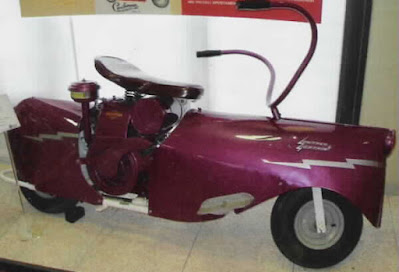It's GONE Scooters are a new, affordable mode of transportation that quickly gained popularity shortly after the end of World War II. Almost all of mainland Europe and even the world feel the vibration of this scooter trend.
 |
| The Neroba Roller attained prototype stage only, and never been produced due to expensive production cost plus the absence of investors who were support the financing. (Picture from: Hannsklemm) |
 |
| Wilhelm Neuscheler posed along with his Neroba Roller scooter. (Picture from: Hannsklemm) |
Apparently this scooter trend is also felt and has attracted the interest of entrepreneurs in those country to produce scooters, which tried to fills a niche that exists in between those two Italian scooter brands, especially for the fulfillment of the domestic scooter market.
 At that time, there were many scooters made by well-known German manufacturers such as DKW Hobby, Glass Gogo, Heinkel Tourist, Zundapp Bella, Dürkopp Diana, Maico Mobil, and others. Among the many scooters there are also names that sound strange to those of us coming from outside Germany such as Bastert Einspurauto, Kroboth Motorroller, Röhr Roletta 200, Riedel Till, Horex Rebell 250, Franke Autoroller, Schweppe Pirol, FAKA-Walba, Venus, Lutz, IWL-made scooters, and many others. And may be many others that are unknown, like this one:
At that time, there were many scooters made by well-known German manufacturers such as DKW Hobby, Glass Gogo, Heinkel Tourist, Zundapp Bella, Dürkopp Diana, Maico Mobil, and others. Among the many scooters there are also names that sound strange to those of us coming from outside Germany such as Bastert Einspurauto, Kroboth Motorroller, Röhr Roletta 200, Riedel Till, Horex Rebell 250, Franke Autoroller, Schweppe Pirol, FAKA-Walba, Venus, Lutz, IWL-made scooters, and many others. And may be many others that are unknown, like this one:  |
| The overall design of the Neroba Roller is similar to another classic German scooters at the time. (Picture from: Scooters of Germany Group) |
 |
| The Neroba Roller was designed with such a nice backbone construction made of cast aluminum to support the body. (Picture from: Hannsklemm) |
According to Mr. Marco Bohème, initially he got this unique scooter information from the old magazine Klassik Motorrad Nr.6 edition of November-December, 2010. Too bad we don't have and get the mentioned old magazine physically, so in the case we only got less information about the Wilhelm Neuschler made scooter virtually through the Facebook's pages and the Hannsklemm sites.
As quoted of Hannsklemm, the Neroba Roller prototype was developed by Wilhelm Neuscheler, when he and his family moved to Rommelsbach shortly after the end of World War II in late 1949 or early 1950. Later to commercialize his designed scooter, he also founded a company named Neroba (short of Neuscheler Rommelsbach).
 |
| There's no information regarding the drivetrain of the Neroba Roller scooter, but it looks like the Neroba Roller is powered by a 150cc or 175cc 2-stroke engine. (Picture from: Hannsklemm) |
Furthermore, the Neroba Roller is designed with such a nice backbone construction made of cast aluminum to support the body. While viewed of the front, it looks rounded similar to the bullet with a single large headlight. Too bad we also didn't find any information regarding the drivetrain of this scooter, but it looks like the Neroba Roller is powered by a 150cc or 175cc 2-stroke engine.
Uniquely, the German-made scooter has a trunk above the front wheels and some said make it to be hardly to ride. In our opinion it's unlikely, as you can see from the pictures the Neroba Roller's front body is separate from the scooter controller construction. What do you think?
 |
| Unfortunately there are none left today, and seems that all of the Neroba Roller scooters are lost with the passage of time. (Picture from: Hannsklemm) |
 Due to the high production costs, worsened by the absence of investors who were support the financing, at the end this scooter made by Neuscheler never entered the production line. And as written on an article on of the Automarkt trade journal of February, 1954 issue stated that there're only 10 units of the Neroba Roller scooters ready for sale at the time. Unfortunately there are none left today, and seems that all of those Neuscheler-made scooters are lost with the passage of time.😭
Due to the high production costs, worsened by the absence of investors who were support the financing, at the end this scooter made by Neuscheler never entered the production line. And as written on an article on of the Automarkt trade journal of February, 1954 issue stated that there're only 10 units of the Neroba Roller scooters ready for sale at the time. Unfortunately there are none left today, and seems that all of those Neuscheler-made scooters are lost with the passage of time.😭And if the article above is still considered inadequate or inaccurate, or if you have additional information related to this marque, please don't hesitate to let us know via the comments column below the article.
Kept spur your adrenaline on the power of two-wheeled monster and stay alive with the true safety riding. May God will forgive Your sins and so does the cops...... *** [EKA | FROM VARIOUS SOURCES | SCOOTERS OF GERMANY GROUP | HANNSKLEMM ]
Note: This blog can be accessed via your smart phone.





































